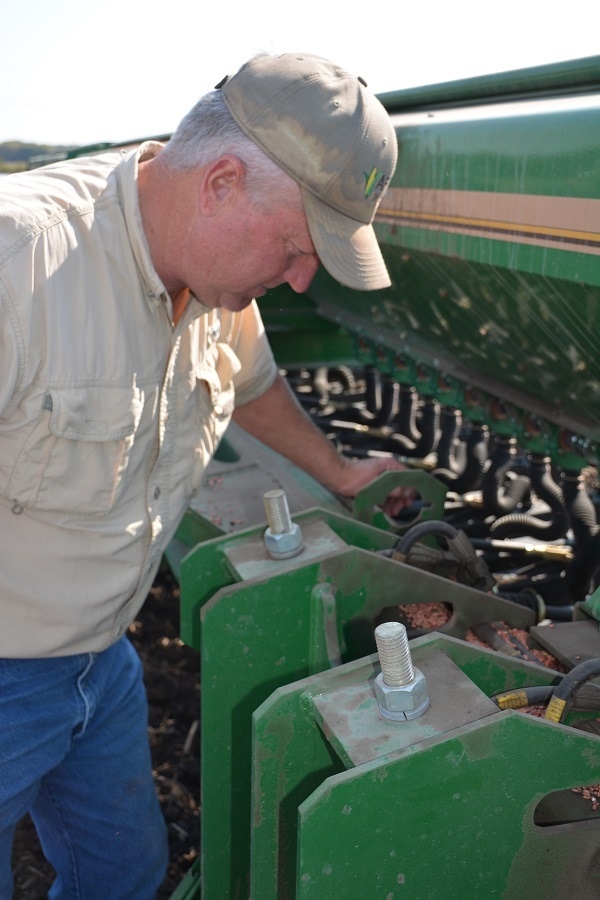
Mike Fallon figures he can make a little profit on 60-bushel per acre wheat, even at current prices.
“But we would be disappointed in that yield now,” he said in late October as he planted the 2015 crop.
Fallon and other Northeast Texas wheat farmers harvested the best wheat crop they ever made early last summer, and that crop followed No. 2 and No. 3 on the all-time best yield list.
“The last three years were really good,” he said. “Last year was the best we ever had and averaged right at 90 bushels per acre. We can see a pretty good profit potential at that yield.”
Fallon, who farms with his brother, Pat, in Grayson County, Texas, says they had never approached yields at that level before three years ago. That 60-bushel mark was a reasonable yield goal.
Timely rainfall played a big part in those record yields. Farmers also dodged freeze damage and losses to disease and insect pests. But Fallon says they have better tools than they used to, which makes it possible for them to take advantage of timely rainfall and other beneficial climate conditions. For one thing, they can plant later.
For the latest on southwest agriculture, please check out Southwest Farm Press Daily and receive the latest news right to your inbox.
The main advantage, he says, is “an economical fungicide, tebuconazole. That allowed us to shift away from earlier varieties to later maturing wheat, which gives us a longer grain-fill period and reduces potential for freeze damage.”
Economical seed treatment also plays a role. “That improves plant health,” Fallon says. “Barley yellow dwarf was hurting us a lot more than we realized. We probably also lost some yield to light greenbug and aphid infestations.”
He says a seed treatment, including a fungicide and an insecticide, costs less than $4 per acre to apply, an economical option.
He says the fungicide bumped yield potential from 50 to 60 bushels per acre. The seed treatment added more. Better varieties put a few more bushels in the bin.
He plants mostly Pioneer 25R30 and 25R40 and Terral 8861. “All three of those yield at about the same level,” he says, “and we saw some fields top 100 bushels per acre.” The three varieties are rated medium-late maturity.
He looks at other varieties from time to time to see how they will perform and is planting some USG 3555 for grazing in a commercial cattle operation.
“But we plant most of our acreage in the top three, and I would not hesitate to plant all the acreage in either one of those.”
Good investments
He says seed and fertilizer are good investments. “Seed and fertilizer are the best places to spend your money,” he said.
He applies phosphate and ammonium sulfate in wheat at planting. “We don’t use nitrogen pre-plant because we don’t want too much early vegetation. “We make one nitrogen application in the winter.”
The Fallon brothers typically split acreage equally between corn and wheat. “This year we’re planting two-thirds of the land to wheat,” he says. “We save some money on wheat versus corn, and we’ve gotten a pretty good price for wheat.”
The 2014 corn crop “was also good, a little better than the last two seasons. We made some 80-bushel corn and some 185-bushel corn. A late freeze did some damage and certain varieties were hurt pretty bad.”
Milo acreage also produced well, as high as 7,500 pounds per acre. “Other fields did not do as well.”
Fallon says they run “an economical dryland corn operation. AF-36 (an atoxigenic strain of aspergillus flavus) makes a big difference and helps us manage the aflatoxin issue.”
Aflatoxin was a scourge for area corn farmers until just a few years ago until they started applying AF-36 or Afla-Gard routinely.
“It changed the industry in our area,” Fallon says. “We now have a good market and no steep discounts. Before, a lot of places wouldn’t buy corn from this area. We’ve gotten some of those back. AF-36 is an important tool.”
The non-toxic fungus goes on corn acreage early enough to gain a foothold before the aflatoxin fungus can develop. Farmers who have used one of these products say aflatoxin contamination levels have dropped significantly in the past few years. Most now consider application of one of these products a necessary production expense.
Fallon said early planting conditions this year were good, though a little wet at the beginning. He was “just getting started,” in late October and hoped for continuation of timely moisture that helped the last three wheat crops.
“Good water is the most critical issue we face for economic grain production,” he says.
About the Author(s)
You May Also Like






